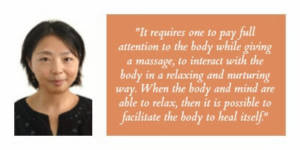
Today we sat down with Wynnie Ng who is one of our massage tutors in the Holistic Diploma Course and soon will extend her teaching to the Journey of Discovery, Vibrational Medicine and Mind Body classes of the subject Holistic View.
Wynnie is a qualified holistic aromatherapist and massage therapist, a graduate of Asia-Pacific Aromatherapy (APA). She is a certified ISBT Bowen Therapist and Body Talk Access practitioner, and trained in Tui-Na Massage, Manual Lymphatic Drainage and Indian Head Massage.
We asked her how she combines these different therapies in her work, what students can expect to learn in Vibrational Medicine and her best tips for future aromatherapists:
1) Wynnie, your passion is to assist people in restoring the wellness of their physical body as well as their energy bodies. In your massage work you combine various therapies. Can you tell us more about it?
The physical body is a tangible part of the body-mind-spirit connection. Body tension can be a result of various factors, such as physical and chemical imbalances, or caused by stress, buried emotions, limited thoughts and beliefs. When the body begins to relax during a treatment, what has been held tight and buried unconsciously will begin coming to the surface for release. Apart from giving massage, I will bring in other tools, if needed, such as re-balancing the body meridians and chakras to harmonize the energy flow, introducing breath work to acknowledge and ease any discomfort, or simply be there for the person, giving the time and space needed for the release to take place.
2) Recently you’ve included “Vibrational Medicine” in your teaching. What can students expect to learn?
Vibrational Medicine is one of the subjects in the Asia Pacific Aromatherapy Holistic Diploma Course. It is aimed to invite the students to consider the different principles between orthodox medicine and vibrational medicine. Leading students to the awareness of different forms of well-practiced vibrational medicine, such as flower essences and homeopathy. Introducing the concept of the human energy system in different traditions, including chakras and meridians. Through exercises, the students can explore the existence of energy fields of the body. It is a fun and mind-opening learning experience.
3) Your are one of APA’s massage tutors in the Holistic Diploma Course – what is your most important tip you give your students?
It is important to practice therapeutic touch, where sensitivity, care and respect are present. It requires one to pay full attention to the body while giving a massage, to interact with the body in a relaxing and nurturing way. When the body and mind are able to relax, then it is possible to facilitate the body to heal itself.
It is equally important for the students to learn taking care of themselves, such as maintaining a good posture and breathing properly when giving massage, to observe and address their stresses and needs when going through changes, fine tuning a positive attitude and discipline to turn challenges into opportunities for growth and learning.
From a holistic view, it takes into consideration the well-being of all aspects of a human being, whether it is physical, emotional, mental or spiritual. To facilitate others to restore wellness and health, therapists/caretakers would be more of assistance if mindful about taking care of themselves and bringing their own wellness and health into balance.
Thanks so much, Wynnie! If you are interested to learn more about Vibrational Medicine and the body-mind-spirit connection, have a look at our upcoming Diploma Courses or email us your questions!
